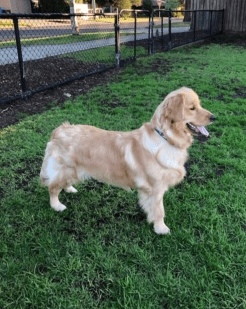Arthritis Is Not Ageing.
Meet Willow, a beautiful Golden Retriever puppy. She has been in to visit us a few too many times in her short life.

Willow started to become sore on the left back leg. Initially, it was only every now and then, after exercise or when she had been laying down for long periods. Willow’s lameness worsened and she became lame all the time. At first she started to improve with pain anti-inflammatory painkillers but she had become refractory to this treatment. It was time for some x-rays to assess the back legs. I say back legs as being the typical wiggly, squirmy excitable Golden Retriever, it was difficult to assess where the pain was coming from. The x-rays showed little change except a slight swelling within the ankle joint. A severe sprain or something else, time would tell.
It was not long before we arranged Willow to have a keyhole arthroscopy of the joint with our visiting specialist Dr Ralph. A small camera was inserted into the ankle joint . To everyone’s surprise Ralph found a large, loose cartilage fragment that involved whole outside surface of one of the ankle bones.
Why could we not see the fragment on x-ray you ask? Cartilage is not calcified so does not normally show up on x-ray.
I say surprised because normally this condition does not occur in that part of the ankle joint. it was one of the largest fragments the specialist had ever seen! Osteochondrosis or OCD for short, is a congenital problem in growing large breed dogs. The cartilage surface is poorly formed , irregular and unstable resulting is cartilage fragments floating freely in the joint causing pain. In the long term this leads to arthritis.
The worry was, with the fragment being so large she would continue to be in pain and require surgical fusing of the joint. So far Willow has proved us all wrong! She recovered well from surgery and is back to her normal, excitable puppy self. Removing the fragment has stopped the pain and will slow progression of arthritis in the ankle joint. With a few exercise modifications Willow is now back to harassing her big sister Piper, another beautiful Golden Retriever, and loving life.
Willow will continue to develop osteoarthritis. Fortunately for Willow, early intervention means we have slowed the onset and have controlled the pain so she enjoys a full, happy and comfortable life.
20% of dogs by the time they are 12 months old will have evidence of arthritis. Staggeringly, 80% of dogs will have evidence of arthritis by the time they are 6 years old, As people we always think arthritis is a disease of ageing. It’s not always true.





